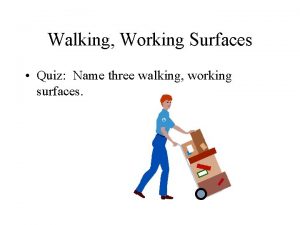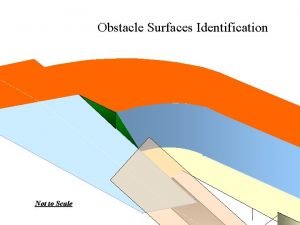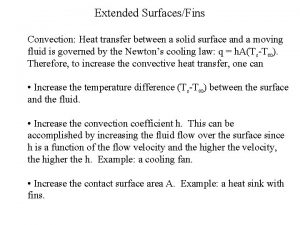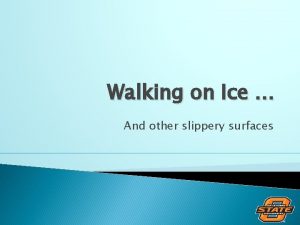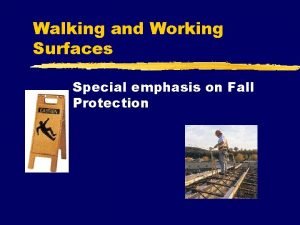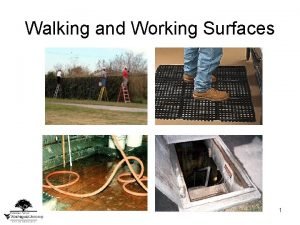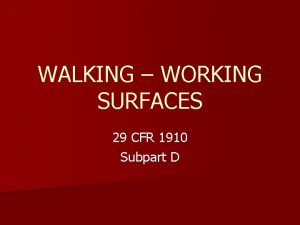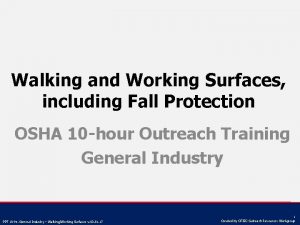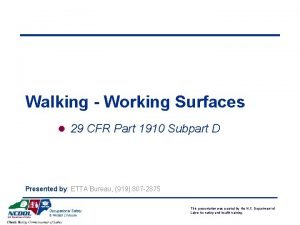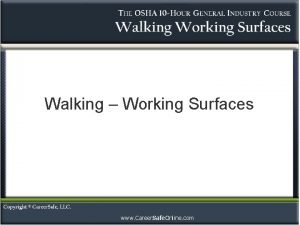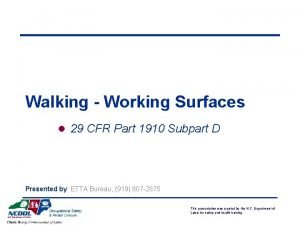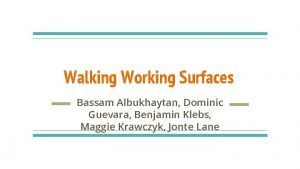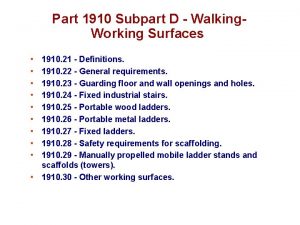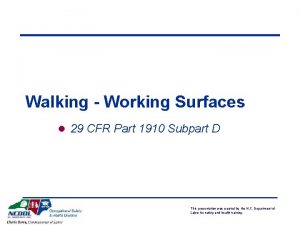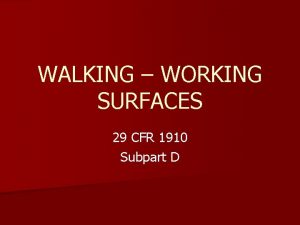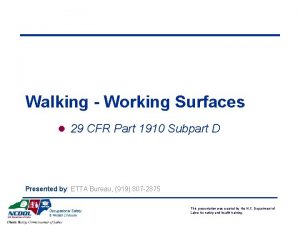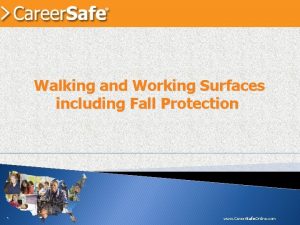Walking Working Surfaces Quiz Name three walking working






















- Slides: 22

Walking, Working Surfaces • Quiz: Name three walking, working surfaces.

Answer • • • Floors Ladders Stairways Platforms Walkways Scaffolding

QUIZ • NAME THREE TYPES OF LADDERS. FIXED STEP EXTENSION

Which of the following will you not find on an extension ladder? • • STEP RUNG CLEAT FEET

DEFINITIONS • Floor Hole- opening measuring less than 12 inches and more than 1 inch. • Floor Opening- opening measuring more than 12 inches. • Handrail- a pipe or single bar supported on brackets, as on a stairway or ramp, to furnish persons a handhold.

Platform- an elevated working surface above the surrounding floor or ground. Toeboard- a verticle barrier constructed at the edge of a runway, floor opening, platform or ramp to prevent falls of materials. (4 inches) Riser- The upright member of a step situated at the back of the lower tread and at the leading edge of the next higher tread. Tread- the horizontal member of a step.

Ladders: an appliance consisting of two side rails joined at regular intervals by cross pieces called steps, rungs, or cleats, on which a person may step either descending or ascending. Types: Stepladder Single Ladder Extension Ladder Sectional Ladder Trestle Ladder Trolley Ladder Side Rolling Ladder

Railings- a barrier constructed along the edges of a floor opening, ramp, platform or runway to prevent falls of persons. Top Rail- 39 - 42 inches high Mid Rail- midway between floor and top rail Vertical Member- every 8 feet. Must be able to withstand 200 pounds of pressure. Pitch- the angle between the horizontal and the ladder, measured on the opposite side of the ladder from the climbing side.

Rungs- ladder cross pieces of circular or oval cross-section on which a person steps ascending or descending. Cleats- ladder cross pieces of rectangular crosssection placed on edge on which a person steps ascending or descending. Steps- flat cross pieces of a ladder on which a person may step ascending or descending. Cage- a guard or basket guard fastened to a fixed ladder to encircle the climber to prevent falls- 7’.

Guardrail- a rail secured to uprights and erected along the exposed sides and ends of platforms. Scaffold- any temporary elevated platform and its supporting structure used to support workmen or materials or both.

General Requirements • Housekeeping: – All places of employment, passageways, storerooms, and service rooms shall be kept clean, orderly and sanitary. – Floors must be kept clean and dry. Where wet processes are used drains shall be maintained and false floors, mats or other dry standing places should be provided. – Working surfaces shall be kept clear of protruding nails, splinters, holes or loose boards

Aisles and Passageways • Sufficient, safe clearances must be maintained for aisles, at loading docks, through doorways and wherever turns or passage must be made. • Aisles and passageways shall be kept clear and in good repairs, with no obstructions across or in aisles that could create hazards. • Permanent aisles and passageways must be marked.

Covers and Guardrails • Covers and/or guardrails must be provided to protect personnel from the hazards of open pits, tanks, vats, ditches, etc.

Guarding Floor and Wall Openings • Any floor opening must be protected as follows: – Stairway openings by guardrails. – Ladderway or platform openings by guardrails. – Hatches or chutes by one of the following: • • Hinged floor opening cover. Removable guard rail with toeboard. Skylights by skylight screen or railing. Pits, manholes, temporary openings, etc. by covers or railings.

Fixed Stairs • Fixed stairs shall be provided for access from one level to another where regular travel between levels is anticipated. • Stairs must: – Be able to carry a load five times expected load.

• Have a minimum width of 22 inches. • Be installed at angles to the horizontal of between 30 and 50 degrees. For example: Angle to Horizontal 30 degrees 49 degrees Rise ( inches) Tread Run (inches) 6½ 8 9½ 11 9½ 8 • Treads and nosings shall be slip resistant. • Stairway platforms shall be no less the width of the stairs and at least 30 inches in length.

• Railings shall be applied on the open side. • Handrails shall be provided on at least one side of a closed stairway, preferably the right side-descending. Sorry all you left handers. • Vertical overhead clearance shall be at least seven feet.

Portable Wood Ladders • Stepladders more than 20 feet shall not be supplied. • Step spacing cannot be more than 12 inches. • Minimum width between side rails at the top shall not be less than 11 ½ inches. From top to bottom side rails shall spread at least 1 inch for every foot of length of the stepladder.

• Single ladders longer than 30 feet shall not be used. • Two section extension ladders shall not be longer than 60 feet. • Ladders must be maintained in good shape at all times, joints must be tight, all hardware must be securely attached and moveable parts operate freely without binding. • Safety feet shall be used and kept in good condition.

• Never paint wood ladders. • Question: When using a portable extension ladder, how does one figure the pitch-or angle the ladder must be placed on the wall? ANSWER- The horizontal distance from the top support to the foot of the ladder must be one quarter of the working length of the ladder or 1 foot from the wall for every 4 feet of height.

• Tops of stepladders shall not be used as steps. • No ladder can be used to access to a roof unless the ladder extends at least 3 feet above the roof or surface. • Portable stepladders fall into the following categories: • Type I- Industrial Stepladder, 3 to 20 feet, for heavy duty use such as contractors or industrial use. Type II- Commercial Stepladder, 3 to 12 feet, medium duty use such as painters or offices. Type III- Household stepladder, 3 to 6 feet, for light duty, such as light household use.

SUMMARY • In one way or another, walking, working surfaces figure into many workplace injuries. • A good knowledge and understanding of these working surfaces will prevent injuries.
 Walking and working surfaces quiz
Walking and working surfaces quiz Walking working surfaces
Walking working surfaces Walking on slippery surfaces
Walking on slippery surfaces Name
Name Working smart vs working hard
Working smart vs working hard Cold working of metals
Cold working of metals Hot working and cold working difference
Hot working and cold working difference Differentiate between hot working and cold working
Differentiate between hot working and cold working Contoh hot working
Contoh hot working Inductive vs deductive reasoning math
Inductive vs deductive reasoning math Inductive vs deductive
Inductive vs deductive Face of rectangular pyramid
Face of rectangular pyramid Subdivision surfaces in character animation
Subdivision surfaces in character animation In discrete statistical surfaces the z values occur
In discrete statistical surfaces the z values occur Reflection it
Reflection it Human heart border
Human heart border Obstacle identification surface icao
Obstacle identification surface icao Interpenetration of solids
Interpenetration of solids Orthographic projection inclined surfaces
Orthographic projection inclined surfaces Pyramid examples
Pyramid examples Ted bundy bite mark
Ted bundy bite mark Imaginary surfaces
Imaginary surfaces Advection vs convection
Advection vs convection
